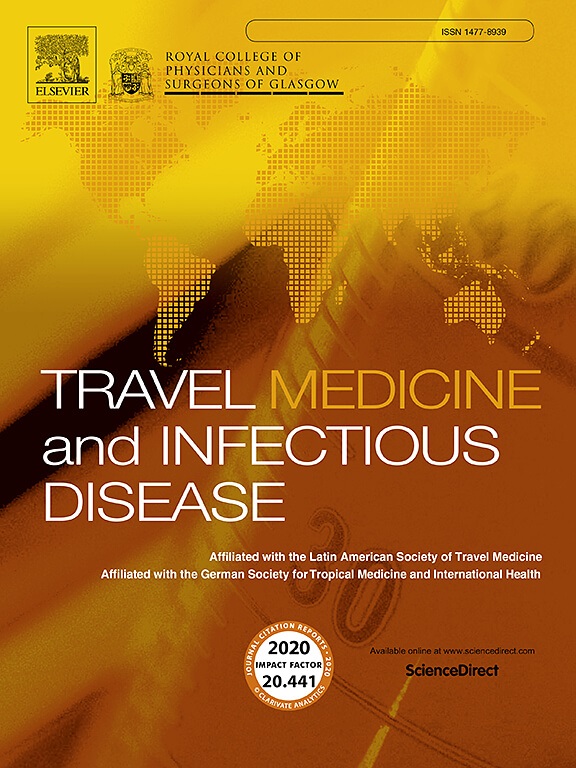意大利新移民肠道原生动物微生物的遗传特征及其与肠道微生物群布局的相关性
IF 4.7
3区 医学
Q1 INFECTIOUS DISEASES
引用次数: 0
摘要
在2022-2024年期间从非洲国家来到意大利的一组新移民中,对肠道原生动物微生物的流行、遗传特征及其相关肠道微生物组进行了分子和16S宏基因组特征分析。199个个体中,92个(46.2% %)携带原生动物微生物,其中囊虫(15.5% %)患病率较高,其次是十二指肠贾第虫(12.6% %)、脆弱地阿米巴(7.5% %)、细小隐孢子虫(6.5% %)和溶组织内阿米巴(4% %)。Blastocystis sp.的ST1、ST2和ST3亚型,G. duodenalis的A和B组合,C. parum的IIa和IIc亚型,D. fragilis的1基因型。在原生动物非携带者个体组中,发现丁酸弧菌、毛螺科UGC 10和Paraprevotella高发。这项工作阐明了肠道原生动物微生物在来自非洲国家的明显健康移民中的循环,以及与宿主-微生物组组成的潜在关系。此外,这些结果概述了在抵达东道国的移民和寻求庇护者中进行微生物调查的重要性,以便评估通过移民引入几种微生物的可靠风险。最终,进一步研究肠道微生物群与原生动物微生物之间的相互作用将为肠道感染的诊断和治疗提供新的途径。本文章由计算机程序翻译,如有差异,请以英文原文为准。
Genetic characterization of enteric protozoan microorganisms in newly arrived migrants in Italy and correlation with the gut microbiome layout
The prevalence of the enteric protozoan microorganisms, its genetic characterization as well as its associated gut microbiome has been molecularly and 16S metagenomic characterized in a cohort of newly arrived migrants in Italy from African countries over the period 2022–2024. Out of 199 individuals, 92 (46.2%) were found to be carrier of protozoan microorganisms with a higher prevalence of Blastocystis sp. (15.5%), followed by Giardia duodenalis (12.6%), Dientamoeba fragilis (7.5%), Cryptosporidium parvum (6.5%), and Entamoeba histolytica (4%). Subtypes ST1, ST2 and ST3 were genetically characterized for Blastocystis sp., assemblages A and B for G. duodenalis, subtypes families IIa and IIc for C. parvum and genotype 1 for D. fragilis. High prevalence of Butyrivibrio, Lachnospiraceae UGC 10 and Paraprevotella, were identified in the protozoan non-carrier individual group. This work shed lights on the circulation of enteric protozoan microorganisms in apparently healthy migrants from African countries and the potential relationship with the host-microbiome composition. Moreover, these results give an overview of the importance of microbiological surveys among migrants and asylum seekers arriving to hosting countries in order to evaluate the reliable risk of several microorganisms introduction though migration. Ultimately, further investigation of interplays between the intestinal microbiota and protozoan microorganisms will provide new approaches in the diagnosis and treatment of intestinal infections.
求助全文
通过发布文献求助,成功后即可免费获取论文全文。
去求助
来源期刊

Travel Medicine and Infectious Disease
PUBLIC, ENVIRONMENTAL & OCCUPATIONAL HEALTH-INFECTIOUS DISEASES
CiteScore
19.40
自引率
1.70%
发文量
211
审稿时长
49 days
期刊介绍:
Travel Medicine and Infectious Disease
Publication Scope:
Publishes original papers, reviews, and consensus papers
Primary theme: infectious disease in the context of travel medicine
Focus Areas:
Epidemiology and surveillance of travel-related illness
Prevention and treatment of travel-associated infections
Malaria prevention and treatment
Travellers' diarrhoea
Infections associated with mass gatherings
Migration-related infections
Vaccines and vaccine-preventable disease
Global policy/regulations for disease prevention and control
Practical clinical issues for travel and tropical medicine practitioners
Coverage:
Addresses areas of controversy and debate in travel medicine
Aims to inform guidelines and policy pertinent to travel medicine and the prevention of infectious disease
Publication Features:
Offers a fast peer-review process
Provides early online publication of accepted manuscripts
Aims to publish cutting-edge papers
 求助内容:
求助内容: 应助结果提醒方式:
应助结果提醒方式:


